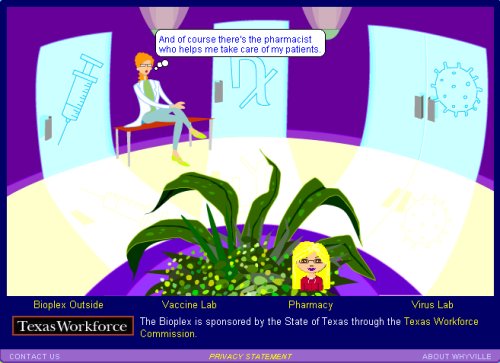
When it comes to the use of virtual environments, the healthcare industry is no less prone to fall into marketing pits of doom than any other industry. Static data, presented in a slap-dash fashion like posters on a wall. Huge, unused buildings that serve no particular purpose, and the occasional video. This seems to be the standard fare presented by companies and organisations coming into virtual environments who are not sensible about use of the medium. Often, these folk would have been better served by a well-organised Web page than the mish-mash they present within virtual environments. Indeed, their attempts are distinctly reminiscent of the early days of the Web, before people got a handle on that medium.
It’s not all bad, however. A couple of companies and organisations have produced useful and significant services that are appropriate for virtual environments. They have clearly thought about how best to discharge the services they already provide to demographics containing the folks they previously had a great deal of trouble reaching. People who use virtual environments, and who:
a) are unable or unwilling to leave their homes to obtain health information or care;
b)Â suffer from chronic illnesses that require some maintenance by the patient that can be bolstered by health information or care delivered online;
c) are young, not requiring specific healthcare, but can benefit from information delivery.
One of the best efforts open to the public eye is Palomar West hospital, a venture by Cisco, Palomar Pomerado Health, and metaverse developers Millions-of-us. The Second Life version of the hospital, built before the real version, is an exact model of what you can expect to see in San Diego in 2011, to the extent that several rooms are fully kitted-out with the sort of equipment that will fill the real thing. The Second Life exhibit is quite interactive, and provides an excellent idea of how things might operate in reality. Cisco Systems will power the real hospital. A central, internal network will be created to support the operation of the hospital, from patient locations via RFID tags, to room temperature and lighting via bedside screens, to the robotic technology that enables surgeons to operate remotely and automated systems for diagnostic work. Incidently, when we wandered past the site to take a closer look, a research study was being conducted. It’s good to know that this virtual environment replica is useful not only for future patients, and public healthcare at that level of education, but also for medical and other professionals.
Another ongoing project that has proved to be successful is one put on by the CDC in Whyville. Whyville is a virtual scientific learning environment for kids aged 8 to 15 years old. During the influenza season in the real world, Whyvillians are also placed at risk of developing the “Why-flu”, which causes sneezing and red spots on the avatar’s face. Not only were kids given the chance to have their avatar inoculated prior to the Why-flu season beginning, during the season those who caught the flu had a chance to buy remedies from the pharmacy, which were time-limited, and which came at a cost. During the second round of the project in 2007-2008, Whyvillians were encouraged to invite their grandparents to come and be virtually inoculated also. Thus information was disseminated across several generations online, and no doubt further than that offline, to other family members, and from there into the wider population.
This year the CDC has teamed up with CIGNA to produce a healthcare island in Second Life.
“About 90% of what we’re doing with chronic disease management involves behavior change. We could do more for our patients who have diabetes, weight problems or hypertension by helping them relieve their stress and achieve better mental health.” This is what they hope to cover in the virtual environment.
We are yet to experience the island for ourselves, however given the success of the Whyville project, it seems that the CDC have an excellent idea of what it takes to sell healthcare information to the younger generation; it will be interesting to see what tack they take for older folk. Most people like to take their medicinal information with a spoonful of sugar – experience will tell whether games will be the sweetener required, or whether talks and general social interaction are the preferential nectar.
Another site of note: the Second Health hospital or Polyclinic, Second Health London in Second Life. In a similar fashion to the West Palomar site (though in less detail), the Polyclinic displays a 3D representation as it might exist in real life. The establishment can be toured, though perhaps the machinima made at the site in Second Life, with accompanying information, is more enlightening. Though an entire medical campus has been built, with signs denoting the areas in which GPs and specialists will see patients, the acute care clinic and diagnostic facilities, none of the detail of equipment or functioning of the clinic has been created.
Yet another fantastic use of virtual environments is exemplified by the folk over at Play2Train. A town and two hospitals have been fitted out to enable “Strategic National Stockpile (SNS), Simple Triage Rapid Transportation (START), Risk Communication and Incident Command System (ICS) Training”.”Play2Train provides opportunities for training through interactive role playing.”
For a quick round up of other nifty virtual doings in healthcare, visit this link.
There is a vast diversity of healthcare information that needs to be delivered, both to professionals and to the general public. Virtual environments may only slowly be coming into their own in this realm, however, there is hope for them yet.
Speak Your Mind